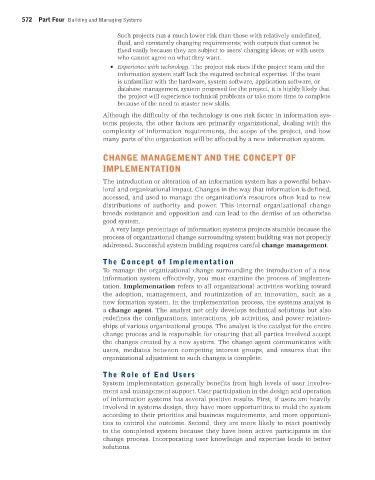Page 573 -
P. 573
572 Part Four Building and Managing Systems
Such projects run a much lower risk than those with relatively undefined,
fluid, and constantly changing requirements; with outputs that cannot be
fixed easily because they are subject to users’ changing ideas; or with users
who cannot agree on what they want.
• Experience with technology. The project risk rises if the project team and the
information system staff lack the required technical expertise. If the team
is unfamiliar with the hardware, system software, application software, or
database management system proposed for the project, it is highly likely that
the project will experience technical problems or take more time to complete
because of the need to master new skills.
Although the difficulty of the technology is one risk factor in information sys-
tems projects, the other factors are primarily organizational, dealing with the
complexity of information requirements, the scope of the project, and how
many parts of the organization will be affected by a new information system.
CHANGE MANAGEMENT AND THE CONCEPT OF
IMPLEMENTATION
The introduction or alteration of an information system has a powerful behav-
ioral and organizational impact. Changes in the way that information is defined,
accessed, and used to manage the organization’s resources often lead to new
distributions of authority and power. This internal organizational change
breeds resistance and opposition and can lead to the demise of an otherwise
good system.
A very large percentage of information systems projects stumble because the
process of organizational change surrounding system building was not properly
addressed. Successful system building requires careful change management.
The Concept of Implementation
To manage the organizational change surrounding the introduction of a new
information system effectively, you must examine the process of implemen-
tation. Implementation refers to all organizational activities working toward
the adoption, management, and routinization of an innovation, such as a
new formation system. In the implementation process, the systems analyst is
a change agent. The analyst not only develops technical solutions but also
redefines the configurations, interactions, job activities, and power relation-
ships of various organizational groups. The analyst is the catalyst for the entire
change process and is responsible for ensuring that all parties involved accept
the changes created by a new system. The change agent communicates with
users, mediates between competing interest groups, and ensures that the
organizational adjustment to such changes is complete.
The Role of End Users
System implementation generally benefits from high levels of user involve-
ment and management support. User participation in the design and operation
of information systems has several positive results. First, if users are heavily
involved in systems design, they have more opportunities to mold the system
according to their priorities and business requirements, and more opportuni-
ties to control the outcome. Second, they are more likely to react positively
to the completed system because they have been active participants in the
change process. Incorporating user knowledge and expertise leads to better
solutions.
MIS_13_Ch_14_global.indd 572 1/17/2013 2:31:59 PM

